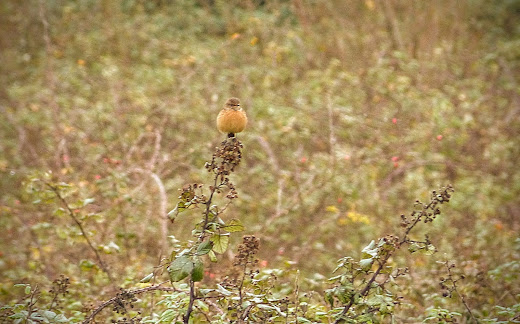Saturday 17th December 2023.
A pair of Ravens greeted us when we made our way to the Hayling Oyster Beds.
Our Mr Fisher was recovering from his Christmas party last night and so it was just Geoff Farwell and myself that went birding this morning. The weather looked promising today, but first thing this morning, there was a lot of low cloud and drizzle around and so we headed off to Hayling Oyster Beds! Why there in grotty cold conditions you might ask; there was a good selection of birds seen there yesterday and I was hoping the weather might improve. Later, we would try Sandy Point to check out the harbour entrance.
Above, a pair of Little Grebes were on the main lagoon on the Oyster Beds and below, the female Long-tailed Duck gave good views this morning despite the poor conditions.


We spent a good couple of hours there and noticed some nice birds that included the following: a female Long-tailed Duck, 5 Black-necked Grebes, 3 Great Northern Divers, a female Common Scoter and a couple of Ravens. Though it looked gloomy over Langstone Harbour and high tide was not until 2pm, we made our way to the nature reserve where we were greeted by a couple of Ravens flying over our heads and heading south towards the car park. The female Long-tailed Duck flew in from the harbour and landed on its favourite lagoon on the Oyster Beds, while out in the harbour (between cleaning the telescope lens from drizzle!), I counted at least 25+ Great Crested Grebes, around a dozen Mergansers and one of the Great Northern Divers swimming on the water. On the lagoon, a pair of Little Grebes and an adult Mediterranean Gull was present, while a pair of Rock Pipits flew overhead. Small numbers of Dunlin whizzed past our heads, heading off to roost somewhere. Out on Long Island, I spotted an interesting large raptor perched on one of the many posts present and although the light was poor because of the drizzle, we both concurred that it was in fact a Common Buzzard.

Above, the female Long-tailed Duck swimming near a Redshank on the Oyster Beds. Below, the Long-tailed Duck took flight and circled around the Lagoon before landing again nearby.


We made our way to the north of the Oyster Beds, near the Hayling Billy Trail and a good scan in the northern half of the harbour that produced a pair of Great Northern Divers, a female Common Scoter and the four Black-necked Grebes, which were most likely the same birds seen yesterday. Great stuff. It seems numbers of this species have dropped considerably, though they do pick up towards the end of winter. More Great Crested Grebes and Mergansers were seen as well as up to four Goldeneye, which included three drakes. The bramble fields east of the Hayling Billy Trail held a female Stonechat, but very little else and even the lagoon there only held a small flock of Mallard. A Cetti’s Warbler was heard singing deep within the scrub, though not seen. The tide was out and therefore there were very few waders around, but a few Redshank were seen and a Common Snipe flew low overhead.
Above, the female Stonechat in the bramble fields by the Hayling Billy Line.
Above and below, the Great Northern Diver flying into the harbour entrance off Sandy Point.
Above, the Great Northern Diver about to settle on the sea by the harbour entrance. Below, a Common Seal popped its head out within the harbour entrance.

Our next stop was to be Sandy Point where we set up camp by the rocks adjacent to the Harbour entrance. There was a lot of boating activity going on within Chichester Harbour and with huge numbers of Red-throated Divers yesterday, I thought it might be more productive to check both the Harbour entrance and the sea. From here, we were soon joined by four of the ‘Lazee Birders’, that included Andy Friend, Simon P, Gary Fennemore and Jim Waterman. Before they joined us, we had a flock of four Red-throated Divers settling on the sea having come in from the east and then they eventually flew off back eastbound. A Great Northern Diver flew into the harbour mouth and also settled on the sea and was later seen flying back out to sea. Other sightings here included a female Common Scoter on the sea and up to at least 6 Great Crested Grebes swam out of the harbour including a flock of four birds. Pairs of both Sanderling and Turnstone were seen to fly out of the harbour and a lone Sandwich Tern was seen flying into the harbour.

Above, sadly, the wader roost at Black Point suffers badly from human and dog disturbance, but there was a good number of waders present (below).
Above, Oystercatchers were roosting on their own island at Black Point and below, a good mixture of waders roosting.
Our final stop was to be by Sparkes Marina to check out the wader roost at Black Point. While enjoying a coffee and a spot of lunch, we checked out the wader roost where there was a reasonably good number of waders roosting here that included Dunlin, Ringed Plover, Grey Plover, Turnstone, Knot, Sanderling and Oystercatcher; though with some pressure from a dog-walker and some kids playing sandcastles nearby, the birds were somewhat quite jittery. Sadly, despite the signs put up to ask people not to disturb the wader roost, the signs are often ignored and have proved to be very frustrating for those trying to count and record the birds here. As mentioned before, I had to get home earlier than usual to do some work with my wife and so made our way back. A good days’ birding nonetheless, despite the poor weather and good to catch up with some of the ‘Lazee’s’ too.
































